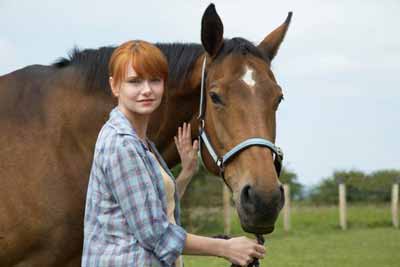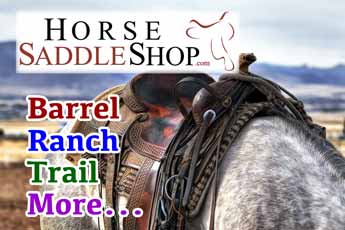This article is by guest author Kevin Hill of Quality Scales Unlimited. Used with permission.
How to Weigh a Horse and Optimize Rider Weight
Weighing your horse regularly is important for more than just one reason.
Not only does weighing your horse(s) help you make sure each horse gets the right quantity of feed, but also the correct dosage of deworming medicine and supplements.

Monitoring changes in a horse’s weight can also help you catch health issues such as tooth problems or digestive disorders early, and help prevent obesity-related colic, founder, and foaling problems. In addition to tracking how much each horse weighs, it’s equally important to make sure you’re weighing them accurately.
Let’s look at common weighing methods, and how your horse’s weight can help you choose the optimum rider weight for them.
3 Common Methods for Measuring a Horse’s Weight
When it comes to weighing livestock, everyone has a method they prefer best. Some even choose to “eyeball” it, but the best thing to do is use weighing scales designed for horses and other livestock.
Here are some common methods used to weigh horses:
1. Weight Tape – Weight tapes found at feed stores and tack shops can be used to approximate a horse’s weight. You need to measure around the horse’s girth area, as well as behind the withers and up over the horse. Make note of the measurement where the tape’s end meets the scale on it.
You can also use regular measuring tapes and compare the measurements against weight charts available online or with a vet. Weight tapes are cheap and easy to use, but they don’t account for height, body type, fat/muscle ratio and other factors, just girth. As such, they aren’t very accurate.
2. Truck Scales – It’s possible to use truck scales for weighing horses, by loading the animal onto your trailer and weighing the whole rig twice, once with and once without the horse. By comparing the weight of the empty rig and the loaded weight, you can estimate the weight of the horse. Local grain elevators often provide this service for a small fee, or sometimes for free.
However, unless you measure both weights on the same day, differences in fuel or equipment loaded in the rig will affect the measurements you get. Other than the extra time and effort required, weight readings using this method are often up to 20-40 lbs. less accurate than those from livestock scales.
3. Livestock Scales – Using a livestock scale is the best way to get an accurate weight measurement for your horses. These instruments are designed specifically for measuring animals that may move around while being weighed, which is why they’re preferred by veterinarians, auction barns and livestock farmers.
Livestock scales are available in a huge range of sizes and styles, designed for all kinds of indoor and outdoor weighing applications, as well as portable scales if you’re weighing animals in different locations. No matter which type you choose, it will offer much higher accuracy than other weighing methods.
If you don’t have a livestock weighing scale, you can always visit your veterinarian or a nearby auction barn to weigh your horses. To measure the weight of newborns, young foals or ponies, you can also stand on a bathroom scale while holding the animal and compare the reading against your weight alone.
Advertisement - Article continues below.
How Much Should a Rider Weigh?
There’s been a lot of debate over how much weight is too much for a horse to handle, and there’s no simple way to determine this yet.
According to most industry practitioners, military experts and preliminary research, a horse can comfortably carry 5-10% of its own body weight, and riders within 10-15% of the horse’s weight are also within an acceptable range. Anything over 20% is commonly considered a welfare issue for the animal, but 5% seems to be optimum for performance horses.
Remember, this is just an estimate. Studies conducted in this area are still too new and there are too many variables to consider. Hopefully, scientists and researchers will have better answers to this question someday soon!
About The Author

Kevin Hill is the content editor and online marketing manager at Quality Scales Unlimited. Always an early adopter and fast learner; Kevin combines his technical knowledge with content marketing in creative ways to give Quality Scales Unlimited a competitive edge.
How To...
… Care For Your Felt Cowboy Hat
… Care For Your Saddle Pad Or Blanket
… Close A Gate With A Chain Latch
… Estimate Cattle Age By Their Teeth
… Fishtail Braid Your Horse's Tail
… Make A Bridle Rack Out Of Tin Cans
… Make A Collapsible Wood Saddle Rack
… Make A Flag Boot Out Of A Horn
… Make Homemade Hoof Conditioner
… Make Homemade Horse Fly Spray
… Measure A Western Saddle Seat
… Put A Horn Knot On Your Rope
… Put A Speed Burner On A Honda
… Recognize Common Horse Colors
… Recognize Common Horse Face Markings
… Stop A Saddle From Squeaking
… Tell A Boy Cow From A Girl Cow
… Tell A Horse Skull From A Cow Skull
… Tie A Stopper Knot
Tie a stopper knot for the end of a rope, or a metal, rawhide, or plastic honda
… Tie A Stopper Knot For A Honda
Tie a stopper knot for a tied honda
… Understand Leather / Hide Thickness
… Weigh A Horse and Optimize Rider Weight
… Wrap A Saddle Horn With Rubber
You Might Also Like...
